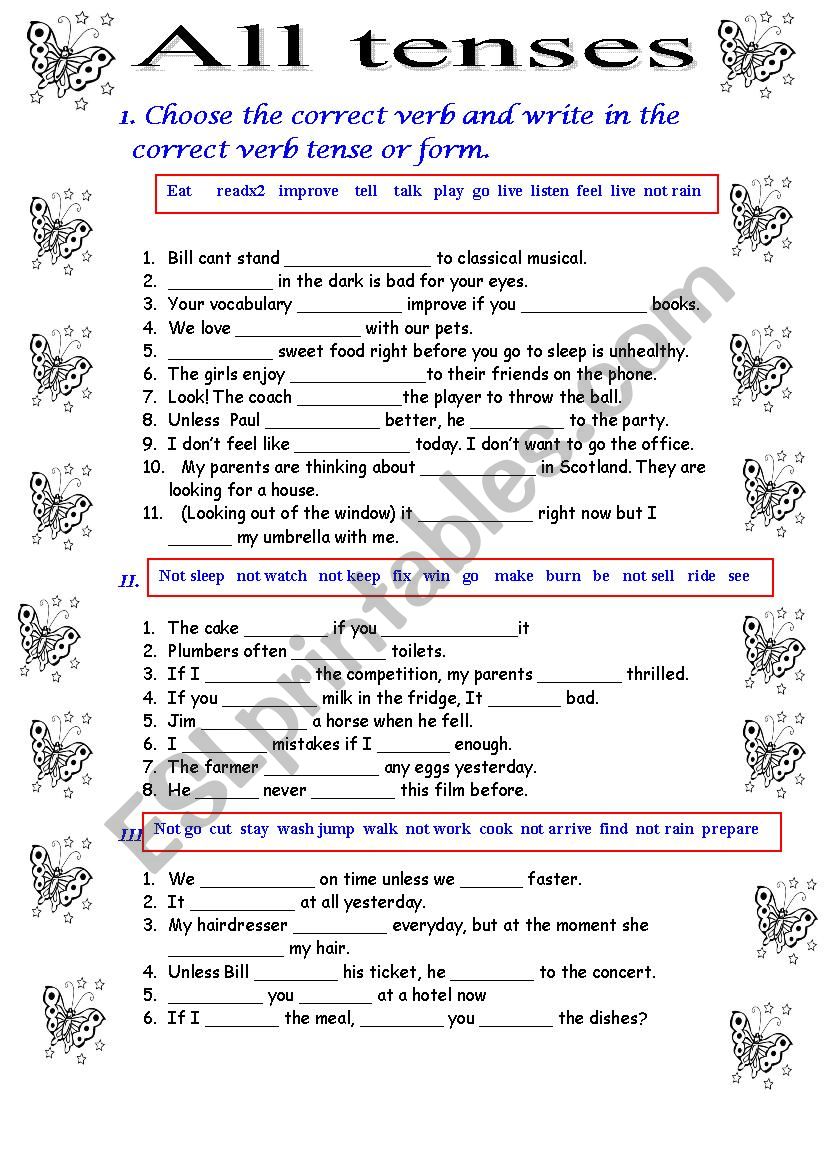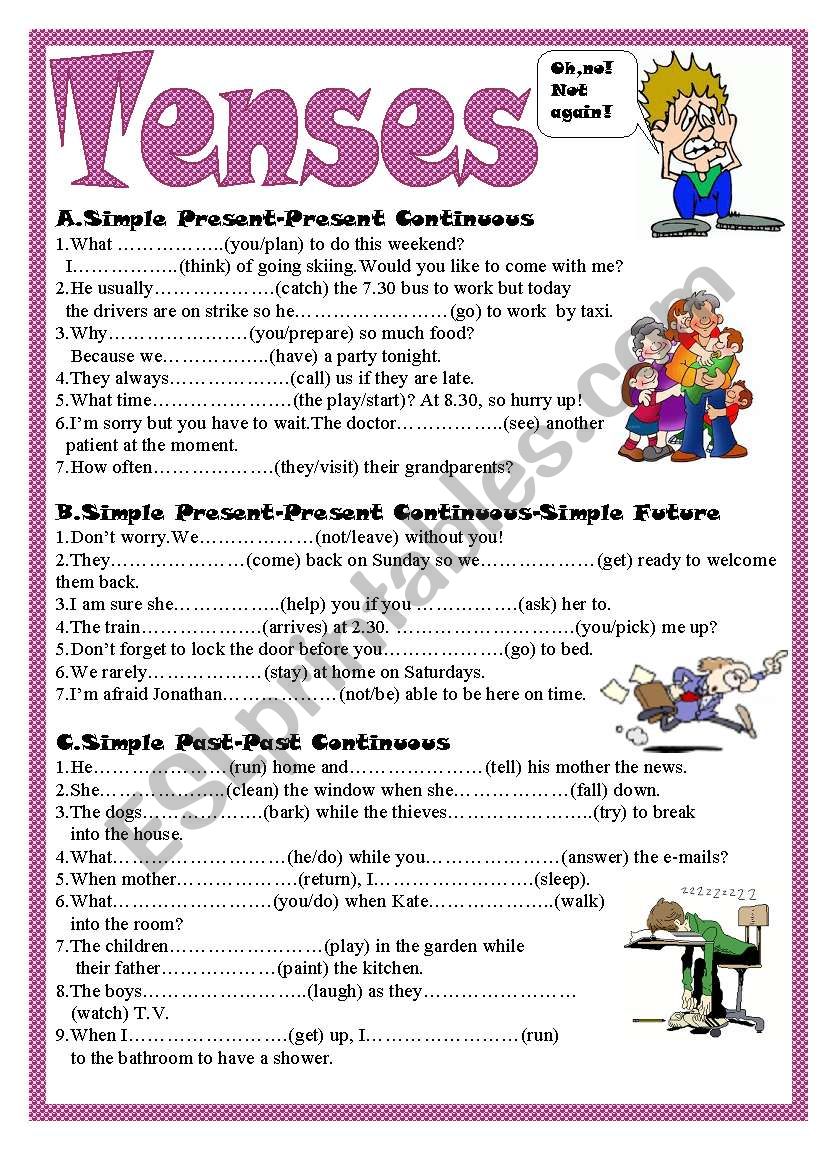
Mastering English Verbs: The Indispensable Role of All Tenses Worksheets
English, with its global reach and intricate nuances, demands a solid grasp of its grammatical foundations. Among these, verb tenses stand as pillars, dictating the timing and state of actions, events, and conditions. Without a precise understanding and application of tenses, communication can become ambiguous, misleading, or simply incorrect. This is where the invaluable resource of all tenses worksheets comes into play, offering a comprehensive and systematic approach to mastering this often challenging aspect of English grammar.
This article delves deep into the significance of these worksheets, exploring their benefits, common structures, effective usage strategies, and why they are an indispensable tool for learners and educators alike aiming for grammatical precision and fluency.
The Cornerstone of Communication: Why Tenses Matter

Before dissecting the utility of worksheets, it’s crucial to appreciate why verb tenses are so fundamental. Tenses provide the temporal framework for every statement we make. Consider the subtle yet profound differences:

- "I eat breakfast." (Habitual action)
- "I am eating breakfast." (Action in progress)
- "I ate breakfast." (Completed action in the past)
- "I have eaten breakfast." (Completed action with relevance to the present)
- "I had eaten breakfast before he arrived." (Action completed before another past action)
- "I will eat breakfast." (Future action)




Each tense conveys a distinct meaning, influencing the listener’s or reader’s understanding of events, their sequence, and their relationship to the present moment. Misusing a tense can lead to misinterpretations, awkward phrasing, and a lack of clarity, hindering effective communication in both spoken and written forms.
For students, professionals, and anyone aspiring to communicate effectively in English, mastering these distinctions is not merely an academic exercise; it’s a practical necessity for expressing complex ideas, narrating events accurately, and engaging in nuanced discussions.

What Are All Tenses Worksheets?
In essence, all tenses worksheets are educational materials specifically designed to provide targeted practice across the full spectrum of English verb tenses. Unlike worksheets that focus on a single tense (e.g., simple past), these comprehensive resources integrate exercises covering:

- Simple Tenses: Present Simple, Past Simple, Future Simple
- Continuous (Progressive) Tenses: Present Continuous, Past Continuous, Future Continuous
- Perfect Tenses: Present Perfect, Past Perfect, Future Perfect
- Perfect Continuous Tenses: Present Perfect Continuous, Past Perfect Continuous, Future Perfect Continuous

Their primary goal is to help learners not only recognize and form each tense correctly but also to understand the subtle contextual differences that dictate their appropriate usage. This holistic approach ensures that students develop a well-rounded understanding of the English tense system rather than isolated fragments of knowledge.
The Unparalleled Benefits of Using All Tenses Worksheets
The systematic and repetitive nature of worksheets makes them an incredibly effective learning tool. When it comes to verb tenses, their benefits are manifold:
- Systematic Mastery: Instead of learning tenses in isolation, these worksheets encourage learners to compare and contrast different tenses, understanding their interrelationships and when to switch between them. This builds a more robust and flexible grammatical framework.
- Diagnostic Tool: As learners work through the exercises, they quickly identify which tenses they struggle with the most. This self-assessment capability allows them to pinpoint specific weaknesses and dedicate more focused effort to those areas, making their study time more efficient.
- Reinforcement and Retention: Repetition is key to memory. By practicing various tenses in different contexts, learners reinforce the rules and patterns, cementing them in their long-term memory. This reduces the likelihood of forgetting rules over time.
- Contextual Understanding: Many exercises in all tenses worksheets present sentences or short paragraphs that require learners to choose the correct tense based on temporal adverbs (e.g., "yesterday," "now," "since 2005") or the logical flow of events. This fosters a deeper understanding of how context influences tense choice.
- Confidence Building: Successfully completing challenging exercises and accurately applying complex tense rules builds a student’s confidence in their grammatical abilities. This increased self-assurance often translates into greater willingness to speak and write in English.
- Exam Preparation: For students preparing for standardized tests like TOEFL, IELTS, Cambridge Exams, or SAT, a strong command of verb tenses is non-negotiable. These worksheets provide targeted practice that directly addresses the grammar sections of such exams, improving scores.
- Self-Paced Learning: Learners can progress through the worksheets at their own speed, revisiting difficult sections as many times as needed without pressure. This makes them ideal for independent study or as supplementary material for classroom learning.
- Identification of Common Errors: Worksheets often highlight typical mistakes made by non-native speakers, helping learners to preemptively avoid them. For example, distinguishing between the simple past and present perfect, a common point of confusion, is frequently addressed.
Common Structures and Types of Exercises
All tenses worksheets employ a variety of exercise types to engage learners and test different aspects of tense usage:
- Fill-in-the-Blanks: The most common type, where learners must choose the correct form of a given verb to fit the sentence, often with contextual clues provided.
- Example: "She ____ (study) English for five years now." (Answer: has been studying)
- Sentence Transformation: Learners are given a sentence in one tense and asked to rewrite it in another tense while maintaining the meaning.
- Example: "He went to the store." (Rewrite in Present Perfect) -> "He has gone to the store."
- Error Correction: Students identify and correct grammatical errors related to verb tenses in given sentences or short passages. This tests their ability to spot incorrect usage.
- Example: "If I would have known, I would have told you." (Correction: "If I had known…")
- Multiple Choice Questions: Learners select the best tense from a list of options, often requiring careful consideration of context.
- Matching Exercises: Tenses are matched with their definitions, uses, or example sentences.
- Question Formation: Learners are given statements and asked to form questions using the appropriate tense.
- Short Paragraph/Story Completion: Students complete a narrative by filling in verbs in the correct tenses, ensuring the logical flow of events. This is excellent for understanding narrative tense shifts.
- Identifying Tenses: Learners are given sentences and asked to name the tense used in each.
The variety ensures that learners are challenged in different ways, solidifying their understanding from multiple angles.
How to Effectively Utilize All Tenses Worksheets
Simply completing worksheets isn’t enough; strategic engagement maximizes their learning potential:
- Review the Rules First: Before attempting a worksheet, quickly review the rules for each tense involved. This primes your brain and refreshes your memory.
- Understand the Context: Pay close attention to time expressions (e.g., "last week," "every day," "by the time," "since"), adverbs, and the overall meaning of the sentence or passage. These are crucial clues for tense selection.
- Don’t Just Guess: If unsure, pause and try to recall the rule or logic behind a tense. Guessing without understanding provides little learning value.
- Check Your Answers Thoroughly: The learning truly happens when you review your work. Don’t just mark right or wrong; understand why an answer is correct or incorrect.
- Focus on Your Mistakes: Identify patterns in your errors. Are you consistently mixing up Present Perfect and Past Simple? Do you struggle with conditional tenses? Pinpointing these recurring issues allows for targeted review.
- Regular Practice is Key: Consistent, even short, sessions are more effective than infrequent, long ones. Make worksheets a regular part of your study routine.
- Integrate with Other Learning: Don’t let your knowledge remain confined to worksheets. Actively try to apply the tenses you’ve practiced in your speaking, writing, reading, and listening.
- Seek Feedback: If possible, have a teacher or a proficient English speaker review your completed worksheets, especially the more open-ended exercises, for insights you might miss.
Who Can Benefit Most?
All tenses worksheets are a universal tool, beneficial for a wide range of learners:
- ESL/EFL Students (All Levels): From beginners struggling with basic past tense to advanced learners perfecting conditional and passive voice tenses.
- Test-Takers: Crucial for anyone preparing for English proficiency exams.
- Academic Writers: Essential for producing clear, coherent essays and research papers.
- Business Professionals: For effective communication in emails, reports, and presentations.
- Self-Learners: Providing structure and measurable progress for those studying independently.
- Teachers: An excellent resource for classroom activities, homework assignments, and diagnostic assessments.
Beyond the Worksheet: Real-World Application
While incredibly effective, worksheets are a means to an end, not the end itself. The ultimate goal is to seamlessly integrate correct tense usage into real-world communication. After working through all tenses worksheets, learners should:
- Read Actively: Pay attention to how native speakers use different tenses in books, articles, and online content.
- Listen Critically: Notice tense shifts in podcasts, movies, and conversations.
- Practice Speaking: Consciously try to use a variety of tenses when talking about past experiences, future plans, or ongoing events.
- Write Regularly: Keep a journal, write emails, or participate in online forums, making a concerted effort to apply the tenses learned.
Conclusion
Mastering English verb tenses is a journey that requires dedication, understanding, and consistent practice. All tenses worksheets serve as an indispensable compass and map on this journey, providing the structured exercises and systematic reinforcement necessary to navigate the complexities of English grammar. By embracing these comprehensive tools and integrating them into a holistic learning strategy, learners can transform their grammatical understanding from theoretical knowledge into practical, fluid, and accurate communication. In a world where clear and precise English is paramount, the investment in mastering verb tenses through these powerful worksheets is an investment in linguistic confidence and communicative success.
